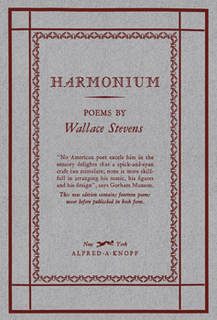Related Research Articles

Wallace Stevens was an American modernist poet. He was born in Reading, Pennsylvania, educated at Harvard and then New York Law School, and spent most of his life working as an executive for an insurance company in Hartford, Connecticut. He won the Pulitzer Prize for Poetry for his Collected Poems in 1955.

Harmonium is a book of poetry by American poet Wallace Stevens. His first book at the age of forty-four, it was published in 1923 by Knopf in an edition of 1500 copies. This collection comprises 85 poems, ranging in length from just a few lines to several hundred. Harmonium was reissued in 1931 with three poems omitted and fourteen new poems added.
"Peter Quince at the Clavier" is a poem from Wallace Stevens's first book of poetry, Harmonium. The poem was first published in 1915 in the "little magazine" Others: A Magazine of the New Verse, edited by Alfred Kreymborg.
"The Snow Man" is a poem from Wallace Stevens's first book of poetry, Harmonium, first published in the October 1921 issue of the journal Poetry.
"Ploughing on Sunday" is a poem from Wallace Stevens's first book of poetry, Harmonium (1923). First published in 1919, it is now in the public domain.
"Depression Before Spring" is a poem from Wallace Stevens's first book of poetry, Harmonium (1923). It was first published in 1918 and is therefore in the public domain.
"Tea at the Palaz of Hoon" is a poem from Wallace Stevens's first book of poetry, Harmonium. It was first published in 1921, so it is in the public domain.
"The Virgin Carrying a Lantern" is a poem from Wallace Stevens's first book of poetry, Harmonium (1923). It was one of the few Harmonium poems first published in that volume, so it is still under copyright. However, it is quoted here as justified by fair use to facilitate scholarly commentary.
"Six Significant Landscapes" is a poem from Wallace Stevens's first book of poetry, Harmonium. It was first published in 1916, so it is in the public domain.
"Anecdote of the Jar" is a poem from Wallace Stevens's first book of poetry, Harmonium. First published in 1919, it is in the public domain.
"Thirteen Ways of Looking at a Blackbird" is a poem from Wallace Stevens's first book of poetry, Harmonium. The poem consists of thirteen short, separate sections, each of which mentions blackbirds in some way. Although inspired by haiku, none of the sections meets the traditional definition of haiku. It was first published in October 1917 by Alfred Kreymborg in Others: An Anthology of the New Verse and two months later in the December issue of Others: A Magazine of the New Verse.
"The Wind Shifts" is a poem from Wallace Stevens's first book of poetry, Harmonium. It was first published in 1917, so it is in the public domain.
"To the One of Fictive Music" is a poem from Wallace Stevens's first book of poetry, Harmonium. First published in 1922, it is in the public domain.
"Hymn From A Watermelon Pavilion" is a poem from Wallace Stevens's first book of poetry, Harmonium. It was first published in 1917, so it is in the public domain.
"The Man Whose Pharynx Was Bad" is a poem from Wallace Stevens's first book of poetry, Harmonium. First published in 1921, it is in the public domain in the United States.
"The Death of a Soldier" is a poem from Wallace Stevens's first book of poetry, Harmonium. The poem uses free verse to describe the death of a soldier.
"Sea Surface full of Clouds" is a poem from the second, 1931, edition of Wallace Stevens's first book of poetry, Harmonium. It was first published in 1924, so it is restricted by copyright. However, brief parts of it are quoted here as fair use, and the whole poem is available elsewhere on the Internet.
"Lunar Paraphrase" is a poem from the second (1931) edition of Wallace Stevens's first book of poetry, Harmonium. One of Stevens's "war poems" from "Lettres d'un Soldat" (1918), it is in the public domain.
"Tea" is a poem from Wallace Stevens's first book of poetry, Harmonium. It was first published in 1915 in the journal Rogue.
Frank Aristides Doggett was an educator in the Duval County, Florida school system and an independent scholar who was an early authority on the American Modernist poet, Wallace Stevens. Doggett was born in Jacksonville, Florida, earned a bachelor's degree at Rollins College in Winter Park, Florida and his master's degree at Emory University. He received an honorary doctorate of letters from the University of Florida in 1967 for his contributions toward the understanding of Stevens' work.
References
- Doggett, Frank. Stevens’ Poetry of Thought. The Johns Hopkins University Press, 1966.
- Kessler, Edward. Images of Wallace Stevens. Rutgers University Press, 1972.
- Rehder, Robert. The Poetry of Wallace Stevens. Macmillan Press, 1988.
- Riddel, Joseph N. The Clairvoyant Eye: The Poetry and Poetics of Wallace Stevens. Louisiana State University Press, 1965.
- Whalen, Tom. "'Alone in an Immense Valley': A Note on Stevens' `Valley Candle'". Wallace Stevens Journal. 20.2 (Fall 1996)